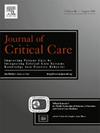危重患者持续使用头孢噻肟达到目标-一项回顾性队列研究。
IF 2.9
3区 医学
Q2 CRITICAL CARE MEDICINE
引用次数: 0
摘要
头孢噻肟是一种β -内酰胺类抗生素,常用于治疗严重肺炎、败血症和脑膜炎。然而,关于危重患者持续使用头孢噻肟的科学文献很少。我们的目的是评估头孢噻肟的给药性能和表征与头孢噻肟血浆水平相关的因素。方法:我们回顾性筛选了连续接受头孢噻肟治疗的危重患者的电子病历——从最初的2g负荷剂量开始,然后每天连续输注6g,同时定期测量头孢噻肟的血浆水平,并根据预定的目标浓度窗口调整剂量。此外,我们提取了广泛的相关临床和实验室参数,并进行了相关和回归分析。结果:所有患者(96/96)最初都达到了头孢噻肟的血浆水平>8 mg/l (>4xMIC断点for Enterobacterales),并且在基于105例患者的338次头孢噻肟单次测量的几乎所有随访测量中保持在8 mg/l以上(236/237)。此外,90%(85/96)的首次血浆水平测量超过了肠杆菌的8倍MIC断点(16 mg/l)。根据估计的肾小球滤过率(eGFR)与头孢噻肟血浆水平之间高度显著的负相关(-0.69[-0.79 - -0.56]),多元线性回归将近50%的血浆水平方差归因于eGFR。结论:我们的现实世界分析表明,即使在肾功能增强的情况下,每天持续给予标准剂量6g头孢噻肟也能确保肠杆菌的血浆杀菌浓度。我们建议根据肾功能正常和肾功能下降的情况,调整每日剂量。本文章由计算机程序翻译,如有差异,请以英文原文为准。
Target attainment with continuously administered cefotaxime in critically ill patients – a retrospective cohort study
Introduction
Cefotaxime is a beta-lactam-antibiotic commonly used in the treatment of severe pneumonia, sepsis, and meningitis. However, there is little scientific literature regarding continuously administered cefotaxime in critically ill patients. We aimed at evaluating cefotaxime dosing performance and at characterizing factors with relevance for cefotaxime plasma levels.
Methods
We retrospectively screened electronic medical records of critically ill patients who had received cefotaxime continuously – starting with an initial 2 g loading dose followed by continuous infusion of 6 g per day - along with regular cefotaxime-plasma-level measurements and dose adjustments according to a predefined target concentration window. Additionally, we extracted a broad range of related clinical and laboratory parameters and conducted correlation and regression analyses.
Results
Cefotaxime plasma levels of >8 mg/l (>4xMIC breakpoint for Enterobacterales) initially were reached in all (96/96) patients and remained above 8 mg/l (236/237) in nearly all follow-up measurements based on 338 single cefotaxime measurements of 105 patients. Additionally, 90 % (85/96) of first plasma level measurements surpassed the eightfold MIC breakpoint for Enterobacterales (16 mg/l). In accordance with a highly significant negative correlation (−0.69 [−0.79 - -0.56]) between the estimated glomerular filtration rate (eGFR) and cefotaxime plasma levels, multiple linear regression attributed nearly 50 % of plasma level variance to the eGFR.
Conclusions
Our real-world analysis demonstrates that continuous administration of a standard dose of 6 g cefotaxime per day invariably ensures bactericidal plasma concentrations regarding Enterobacterales even with augmented renal function. We propose specific adjustments of daily doses for normal and reduced renal function.
求助全文
通过发布文献求助,成功后即可免费获取论文全文。
去求助
来源期刊

Journal of critical care
医学-危重病医学
CiteScore
8.60
自引率
2.70%
发文量
237
审稿时长
23 days
期刊介绍:
The Journal of Critical Care, the official publication of the World Federation of Societies of Intensive and Critical Care Medicine (WFSICCM), is a leading international, peer-reviewed journal providing original research, review articles, tutorials, and invited articles for physicians and allied health professionals involved in treating the critically ill. The Journal aims to improve patient care by furthering understanding of health systems research and its integration into clinical practice.
The Journal will include articles which discuss:
All aspects of health services research in critical care
System based practice in anesthesiology, perioperative and critical care medicine
The interface between anesthesiology, critical care medicine and pain
Integrating intraoperative management in preparation for postoperative critical care management and recovery
Optimizing patient management, i.e., exploring the interface between evidence-based principles or clinical insight into management and care of complex patients
The team approach in the OR and ICU
System-based research
Medical ethics
Technology in medicine
Seminars discussing current, state of the art, and sometimes controversial topics in anesthesiology, critical care medicine, and professional education
Residency Education.
 求助内容:
求助内容: 应助结果提醒方式:
应助结果提醒方式:


